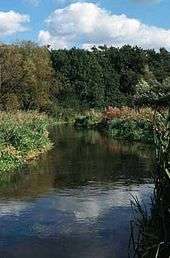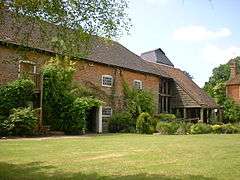Bagnor
Coordinates: 51°25′N 1°21′W / 51.41°N 01.35°W
Bagnor is a hamlet close to the town of Newbury in the English county of Berkshire and situated on the banks of the River Lambourn. At the 2011 Census the population of the hamlet was included in the civil parish of Speen. It is best known as the home of the nationally famous Watermill Theatre. It was recorded in the Domesday Book as Bagenore.[1]
"Humphrey the Chamberlain holds Bagenore from the King. Wulfeva held it freehold from King Edward. Then it answered for 4 hides; now 1 hide. Land for 3 ploughs: In hardship 1 (plough) 3 villagers and 3 smallholders with 2 ploughs. 1 slave: a mill at 20s meadow 22 acres: woodland at 4pigs".
It is located in the West Berkshire district. The Blackbird, a public house, has stood in the village since the 17th century.[2] It is near the villages of Speen, Donnington, Boxford, and Winterbourne. Donnington Castle, a significant site in the history of the First English Civil War, lies less than a mile to the east.[3]
Local government
Bagnor forms part of the civil parish of Speen, which is itself part of the district administered by the unitary authority of West Berkshire.[4]
Watermill Theatre
The Watermill Theatre is a privately owned repertory theatre that has operated since 1981. It is a converted watermill with gardens beside the River Lambourn, and seats 220 people. It retains many of its original architectural features including the waterwheel, which can be viewed through a glass screen on entering the auditorium. Many successful actors have begun their careers at the Watermill Theatre, most notably Sean Bean, Bill Nighy and David Suchet.[5] It is one of only five theatres to have been awarded a National Touring remit by Arts Council England, and previous productions have subsequently moved to Broadway and the West End.[6]
Bagnor Manor
Bagnor Manor is a country home standing near the centre of the village. The house in its current form dates from the 17th century. Previously the manor and its estate had been held for the Crown, and was recorded in the Domesday Book. Ownership was later transferred to Henry de Bagenore, who sold the property to the Priory and Convent of Poughley in 1232. The transfer was agreed in return for a yearly payment of 8 marks, food and clothing for Henry's two sons, and an agreement that the Prior would find a suitor for his youngest daughter, Celestria.
The priory was dissolved in c.1524 and its lands seized by Henry VIII. The Manor was granted to Wolsey College (later Christ Church), Oxford in 1531. Bagnor Manor was later transferred to the Dean and Chapter of Westminster in return for lands in St. James's Park. They built the present Grade II listed building[7] in the 17th century, but the estate did not pass into private ownership until 1871, when it was purchased by a wealthy family from Donnington Grove. Until 2007 it was home to the art collector and property developer Baron Palumbo, who installed many artworks in the house and grounds. It is now a private residence.[8]
Notable residents
A number of notable individuals have lived in the village or its immediate surroundings. They include:
- Jill Fraser MBE, theatre owner and director, who was artistic director of the Watermill Theatre from 1981–2006.[9]
- Lord Hanson, industrialist, who lived on the outskirts of the village.
- Jack Hargreaves OBE, television presenter and author, who bought and converted Brook House on the Winterbourne in 1948, moving on to Lymington in 1960.
- Sir Michael Hordern, actor best known for his performances of Shakespeare, and as the voice of Paddington Bear in the eponymous BBC television series.[10]
- George Melly, jazz musician and writer
- Peter Palumbo, Baron Palumbo, property developer and art collector, who lived in Bagnor Manor.[11]
Rack Marsh

Rack Marsh is a small nature reserve in the village which is managed by BBOWT. It is designated as a Site of Special Scientific Interest (SSSI). It was the scene of protests during the construction of the Newbury bypass which passes close to the east of the village. This was partly due to the presence on the reserve of the rare Desmoulin's whorl snail.[12]
See also
References
- ↑ "The Domesday Book Online: Berkshire A-C". Archived from the original on 30 December 2007. Retrieved 22 December 2007.
- ↑ "The Blackbird Pub". Retrieved 3 May 2009.
- ↑ "Ordnance Survey Get-A-Map". Retrieved 3 May 2009.
- ↑ "West Berkshire Council". Retrieved 3 May 2009.
- ↑ "Watermill Theatre Website – Save the Watermill". Retrieved 7 June 2009.
- ↑ "Watermill Theatre Website – About Us". Retrieved 7 June 2009.
- ↑ "Heritage Gateway". Retrieved 3 May 2009.
- ↑ "Berkshire History". Retrieved 3 May 2009.
- ↑ "Watermill Theatre Profile: Jill Fraser". Retrieved 3 May 2009.
- ↑ "Independent Online "Newbury: What the battle is all about"". The Independent. London. 14 January 1996. Retrieved 3 May 2009.
- ↑ "Independent Online "Newbury: What the battle is all about"". The Independent. London. 14 January 1996. Retrieved 3 May 2009.
- ↑ "SSSI designation for Kennet and Lambourn Floodplain" (PDF). Retrieved 22 December 2007.
External links
| Wikimedia Commons has media related to Bagnor. |
- Rack Marsh on BBC 'Breathing Places' Website
- Bagnor Manor on 'Berkshire History' Website
- Bagnor in the Domesday Book

